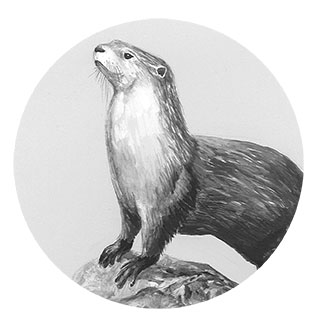In winter, river otters head upstream into the uplands, seeking areas of fast-moving water that remain open—at least open enough for an otter to slip into a stream in pursuit of fish. You might catch a brief glimpse of an otter along one of these smaller streams, as I did years ago with my 2-year-old daughter on the East Branch of the Ompompanoosuc River.
I found signs of otters the next year a mile upriver, as I stood on a rock in the middle of a frozen waterfall. While taking pictures of the icescape, I spotted otter tracks in the thin layer of snow, leading to an open patch of water. Lines of four paw prints showed the tell-tale gait of an animal cantering, with dashes between each series of prints made by the otter’s long, fat tail. Then, plop! the tracks ended at a hole in the ice.
Like many other members of the Mustelidae family, including weasels, river otters have high metabolism. They need to eat 15 to 20 % of their own weight each day. If, when it gets cold, prey becomes scarce in their warm season range, otters move. They are always hunting, traveling from marsh to beaver pond, and up rivers to tributaries. You might identify them from the way they move: a hobby-horsing gait, pushing forward from their back legs, often using their long bodies as springs, which makes their backs compress upwards before releasing. On snow, they will alternate between running and sliding.

On a pound-for-pound basis, otter fur has thermal protection akin to that of a northern fur seal. But air wicks away less heat than denser water, so in the bitter cold, the otters spend most of their time out of the water, husbanding calories. When it gets truly cold, when all the waters in the woods freeze hard, otters can starve for lack of access to the fish beneath. In the coldest times, they stick near marshes and areas of thick water grasses so they can punch through the rotten ice that forms there. Otter mortality in winter is high. Only about half will survive and return to lower waters in the spring; thin, but now playful in the revelry of open hunting waters and a more social existence.
The females will look for a natal den to birth one to three pups. Those young will stay in that den for two months before the mother moves them to one of several dens closer to water. There, they’ll learn how to swim and hunt. Otter pups learn the best local hunting practices from their mothers. Ecologist Megan Isadore, who studies river otters north of San Francisco, found one otter who figured out how to hunt brown pelicans. The next year, Isadore observed the otter teaching her pups these unique hunting strategies—which are now being shared with new generations.
In Isadore’s study area, where the temperatures don’t vary much between seasons, river otters don’t change habitats seasonally, and the pups remain with their mothers for almost a year. But studies conducted here, in northern inland climates, where winter food is scarcer, show family groups typically break up – which some speculate is an adaptation to cover more territory, increasing the likelihood of survival.

I take my kids a longer way to school sometimes, by a backwater where two mother otters return each year with pups. (This detour sometimes causes my children to arrive late, and my daughter, now 13, has suggested that I stop on the way home instead.) The otters may frequent this oxbow because it’s rife with invasive brown crayfish, introduced decades ago by the usual vector: bait buckets. An otter will hold a crayfish straight upwards in its mouth and let gravity push the food down its maw as it rhythmically crunches.
At this site, the otters stay until the ice thickens enough to prevent them from breaking new hunting holes. One group typically leaves a week before the other. In December, it’s easy to spot where the otters have been, as their splashing builds ice rims around these holes. Then, one cold morning, the last mother is gone. In the night air, she moved overland, seeking the falling water that will keep the creek open. The pups will hunt the bottoms for a few more days, and then they, too, will move on.
Tig Tillinghast helps run a forest management software firm out of Thetford, Vermont. He is a frequent photography contributor to Northern Woodlands. Illustration by Adelaide Murphy Tyrol. The Outside Story is assigned and edited by Northern Woodlands magazine and sponsored by the Wellborn Ecology Fund of the New Hampshire Charitable Foundation: nhcf.org.




